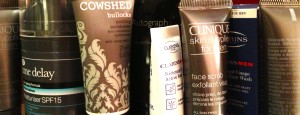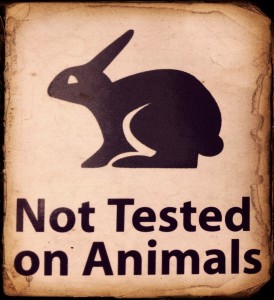As I have confessed before (without pride) I could be perceived as a tad cavalier in my attitude to the products I use on my skin. This is partly because I cannot bear to throw things away and, unless it’s utterly repellent, I will use it till it is done…although more liberally! But with all this recent posting regarding men’s skin, and its differences from women’s and subsequent possible need for special attention, I thought perhaps I should consider the facts and rethink my so-called regime. I say facts because I know that there are strong arguments in many directions that counter attack, discount and sneer at whatever ‘truth’ might be proclaimed. After all, the beauty business is mega and worth a kingly sum to those that corner it.
We’ve all seen the bold exclamations emblazoned across a myriad of products (gifted to us by Hathor and Aphrodite themselves you’d have thought by the adverts accompanying them) announcing the lack of something or other that is therefore apparently better for us. Now you may be savvy in the world of product ingredients and read the packaging and nod sagely at the inclusions or exclusions boasted there. I, I’m not embarrassed to admit, have not a flipping clue. Paraben? Er… Glycol…? Erm… Well, I can have a pretty standard guess at what these things are and I’ve definitely heard of mineral oil but what’s the fuss?! In the name of Venus will someone please just tell me what the deal is?!? But can I find a straight forward answer?? Can I peptide!! Maybe there isn’t one…
I took a quick poll of my friends (all skin types, ages and both sexes) and discovered that the range of knowledge and the divide between the attitudes to synthetic lab created products and natural was quite a spectrum. Also in the understanding of what actually constitutes either of these and how much they might overlap in any single product etc. There were those who almost shrieked at the mention of a high street product, wailing and keening about the chemical toxins contained therein and really sticking the boot into those brands for their lack of humanitarian and environmental care. Their arguments were so convincing that I totally believed them and wanted to instantly change my ideas. I vowed to whip up a batch of home made organic herbal cleanser the minute I’d finished my goats milk latte with hand ground ‘chicory coffee’. Then I spoke to the other end of the spectrum, to those who literally swear by the big name brands anti-ageing products, have no beef whatsoever about synthetic (‘it wouldn’t be allowed if it wasn’t safe!” they’d exclaim), as long as they see results (immediate gratification!) and apply them like a religion and with the strictest of regularity. Such is their belief in the brilliance of the scientists behind these skin regenerating products that I believed them too! So, I immediately vowed to rush out and buy every chemical laden, lab created masterpiece product irregardless of my future or the planet’s – I knocked back my bourbon and thumbed my nose at the crunchy granola naturals. Argh…I’m swinging wildly between the two sides!! But I also encountered those who don’t even sling anything on their skins…at all…and thoroughly poo-poo the exorbitant weekly changing claims of the beauty industry (‘well, they would say that wouldn’t they!’ kinda reaction) and only daub a bit of ‘own brand’ moisturiser on when absolutely necessary – usually literally a minute before their skin cracks open! And when I say ‘moisturiser’ I mean it in the loosest way…
So the truth is in the middle somewhere isn’t it? Has to be! I hope…
As I am particularly exploring the skin care and product possibilities for men I thought it best to ask their thoughts – on specific products, beauty regimes, the outlook for the future of their skin etc. I tried to be as inclusive as possible and asked a range of chaps of all ages, colours and sexuality (genetics, lifestyle, stress etc are factors too, of course). The obvious stereotypes didn’t really play out and it seemed the men that used the most products were usually those with the most awareness or, at least, contact those others who used products! Men with partners that are using products tended to use some too (often the exact same product and usually purchased by that partner also). Most men felt they ‘should’ be using something but many felt it was a palaver at best and certainly weren’t about to begin some three step pre-bedtime regime! The willingness to ‘put up with’ something was greater than I had anticipated. For instance shaving rash was just accepted as part of it all and, even though they admitted they’d like to not have the rash, didn’t take steps of prevent it. Those who used products confessed that vanity played a significant part (therefore a sudden urge to moisturise after the wrinkles began…or a divorce…) or being nagged by a partner who was, after all, the one who had to look at the dry, flaky or rash-y skin! Interestingly very few were bothered about the ingredients, again faith and an assumption of safety, but when pressed did think that natural would be better. Why?! I challenge…just to earn my investigative journalist stripes (I know, it’s hardly gonna challenge Donal McIntyre but stay with me). ‘Dunno really…’ was the usual reply and further questioning revealed that the definition of natural wasn’t remotely clear either. Oh, and it wasn’t to be prohibitively expensive (they’re happy to spend £50 on a liquid night out that’ll rinse straight through them but not on a product that might save their skin…literally). All of them, however, were clear on one thing, they wanted speed and a single procedure – a wonder product that did everything. Oh like self polishing shoes or a pill to create a six-pack, I enquire? No answer was the firm reply…
I’ll level with you, but don’t you dare tell them…if I were to be mean (oh go on then…) the ones who do bog-all (the same ones who apply shampoo and then use the lather on ALL areas of themselves…) looked rougher (but hot in that Hans Solo kinda way) and, at the other extreme, the blokes who spend endless hours smearing some unguent or other on every mentionable and unmentionable part of themselves, looked better (but in a Luke Skywalker kinda way…almost bordering on Princess Leia actually in some cases!) We could spend a good few posts on the psychology of that alone but let’s return to the investigation of the products themselves…shall we?!?
OK, we know we are looking for a product with the least confirmed nasties, that will perhaps do the job of a couple of separate ones and won’t break the bank. Hmmm…
So, the ultimate question we need to answer first is: ‘What’s it to be? Natural or…’…er…hold on what’s the opposite? Not unnatural obviously so…synthetic? Science based? Lab created…? Well, you get the idea…! I’ll run with ‘synthetic’ and you’ll know what I mean. Come to think of it what does ‘natural’ even mean? Well, apparently, a natural product is deemed to be something that has been derived from its organic form without any synthetic additions and then suspended in ‘neutrally occurring medium’ (eh?) to preserve and emulsify it. A ‘natural’ product of one sort or another has been used on the skin for thousands of years. There is abundant evidence the prosecution for the defence could quote to show this. For example, the ancient Egyptians used all sorts of potions derived from all sorts of natural sources (if a little unnerving – crocodile dung and donkey milk as a body wash anyone…no? Just Cleopatra then…awkward…) in an effort to cure all sorts of skin issues. However, I’ve discovered there is currently no official international standard for cosmetics as to what is natural (or organic) and the criteria for natural (and organic) are not legally defined. Hmmm…
To be fair, people aren’t dropping dead from using synthetic hand creams or wiping their faces with lab made cleansers but it does seem logical, at least, to err on the side of caution bearing in mind how much of the many elements that make up a product could potentially enter our bodies, from the lipstick that gets eaten to the nanomaterials (micro particles that can be naturally occurring or synthesised as such) that penetrate your skin’s barrier. Skin largely acts as a waterproof, protective, temperature regulating wrapping but it does absorb substances too (consider nicotine and contraceptive patches). However, more about the truth behind this in a later post…
A word about chemicals though. Everyone is bandying about words like chemicals as if the devil himself has possessed them but don’t be fooled into thinking that a product that says ‘chemical free’ and ‘all natural’ all over the packaging doesn’t contain chemicals – it has to – everything is made up of chemicals technically so it’s just divisive semantics drawing your attention away from where your eye should be – on that ingredient list. Another very important similarity with food consumption! There are rogue chemicals of course but the mere presence of them does not definitively signal something bad. Think on…
Let’s be systematic about this and start with the products that are synthetic – pretty much, at least. Synthetic, by the way, is interestingly defined as ‘made by chemical synthesis especially to imitate a natural product.’ There are, of course, many products on the market that use organically derived plant elements as their base but it is the added supporting ingredients that are the ones the critics are potentially against. We are asked by these companies to bear in mind that many beauty products are very complex and difficult to make and each of these extra ingredients have very specific roles to play and they are all tested and passed as safe. Also, the reputation of these companies is on the line and with over £500 million at stake (and that’s just the estimated yearly spend in the UK on moisturisers alone!) you can imagine they don’t particularly want to put a foot wrong! Just look at the horse meat scandal and the damage it caused to the reputation of many household names and the trust of their buyers…
All cosmetic, toiletry and perfumery products placed on the market in the UK (and throughout the EU) are regulated by European legislation – it’s called the Cosmetics Directive. The purpose of these laws is to protect us and make the manufacturer or supplier of the cosmetic product responsible for ensuring that their products are safe for us to use. The Cosmetics Directive controls what may or may not be put in a cosmetic and only items pre-approved may be used. The controls in the EU are much tighter than the USA (where the industry largely self regulates) and there are over 1100 ingredients banned from use in beauty products by the EU, compared to only 10 banned substances in America.
There is a three tiered process in place in the EU designed to regulate the industry and set the buying public’s mind at ease. The initial multi-level laws and legislation (Cosmetic Directive) followed by rigorous safety assessments. These safety assessments are only allowed to be done by qualified professionals and must assess not only the finished product and all of the ingredients, but also how the product will be used. The criteria and knowledge base these professionals must meet to become assessors are so stringent that there are only around 400 in the the UK. They must be medically qualified, registered pharmacists, Chartered Biologists or Chartered Chemists. And finally, the Trading Standards people can assess the assessors at any moment potentially forcing the cosmetic industry to be accountable for every decision it makes and at every stage. In addition, there is an independent expert scientific committee (SCCS – Scientific Committee on Consumer Safety) that advises the European authorities on safety assessment and the safety of individual ingredients…
..AND there is a EU law (REACH) that governs all chemicals made in or imported into the EU as well as many natural substances used in beauty products, which evaluates and registers them all and records all data regarding their safety in regard to us and the environment.
Crikey…!
It is law that all ingredients used in a product must be listed on the ingredients list for our benefit. This list uses a common naming system so that it can be recognised worldwide, especially for those with specific allergies. I bet very few people do actually read them though…! It’s hardly surprising when the items listed are as unknown and unpronounceable to us as a foreign language.
Synthetic creations are the product of science and new things are constantly being created. Innovations and new technologies have transformed our every day lives and will undoubtedly continue to do so – some great, some arguably not. The benefit of synthetic compounds is found in the stabilisation of some compounds that would ordinarily just deteriorate, or in the reliability of quality and effectiveness and in the ability to use a synthetic version of a compound that would ordinarily be derived from animal sources. Science can replicate some elements perfectly well and the controlled conditions under which they are made can ensure a purer more reliable source. However, as with all these aspects the careful selection and sifting of the truth from the rhetoric is vital.
Natural is still considered better though by the brands that celebrate these sources due to the fact that even though science can replicate some things perfectly well it cannot quite always capture the complexity of nature’s molecules. The scent of a flower in the wild is often sited as an example of this as it is always better (more multi dimensional depth and subtlety) than the lab created version. Some of nature’s compounds used in products have complex multi functions allowing them to have two or more benefits at once – a natural synergy that is hard to replicate.
The sustainability of an ingredient and the environmental issues surrounding this are becoming more high profile. The aggressive harvesting of a certain plant (palm oil is a key example – see following posts) can have dramatic and irreversible consequences on the biodiversity of a natural habitat. Quality control to ensure a reliable source of an ingredient (i.e. from nature or from a laboratory) which does not get produced in a damaging or exploitative way is a factor we all must take some responsibility for.
I asked the most noticeable names on the high street L’Oréal, Clarins, Clinique, Dove, Nivea and Boots No.7 what their position is on these arguments for or against natural and lab created ingredients and, even after lovely chats and positive discussions, not one of them actually answered the questions. The PR departments all just sent me product details and ingredients (which I could get from the Internet anyway so they’re really earning their money aren’t they?!?) but no stance or defence for their products, no supportive evidence of what they are doing, testing, or their ethos/attitude, in any way shape or form, to the actual human element of the business. Why not? Is it because they just think this is small fry and they are far too busy to bother? Maybe. Is it because they simply don’t know or perhaps care? Maybe. Is it because they are in a business to make money and most certainly are and will continue to do so regardless of what I say? Most definitely…
As always and ever the staff at the front line are the most useful. They are always willing to discuss their products but of course can only serve me the party line. I understand this completely and see that their sales, and therefore their jobs, depend on it. Whatever their personal opinions they give me the full pitch. Some frankly admitted they didn’t know the pluses or minuses of the ingredients (outside of the designed product use) and spent time instead describing the way the company plows back into the communities. You know, the usual things, fair-trade programmes, sustainable plantations etc. but all this is harder to investigate because we are not always aware of the complexities of the trade world that brings our desired ingredients to our shopping baskets. (Questions like exactly what have these proudly sustainable plantations replaced? Whose and what’s habitat has been stripped and destroyed?) These salespeople assumed that all the used ingredients are safe (well, the EU says so…), well tested and brilliant to keep us ageless and glowing until death us do part…which is of course exactly what we do isn’t it?
But what if you don’t trust them and the possibilities of rhetoric over substance concern you then you will be looking for the more ‘natural’ brands OR you may well be asking why should I use natural products at all then, when the tests are so rigid and thorough? OR maybe like me you are thinking there is a middle ground here where these two worlds collide and the ideal product is created (this does seem the most logical..captain…)? Perhaps as this question is huge and difficult to answer without emotion and the bias of opinion it’s best to look first at the substances that the pro-natural lobbyists are the most keen to avoid. The natural based brands are the ones who make a concerted effort to support and validate their choices and reasons for excluding certain ingredients. The most denounced are investigated next, in Part 2…
See you then…




